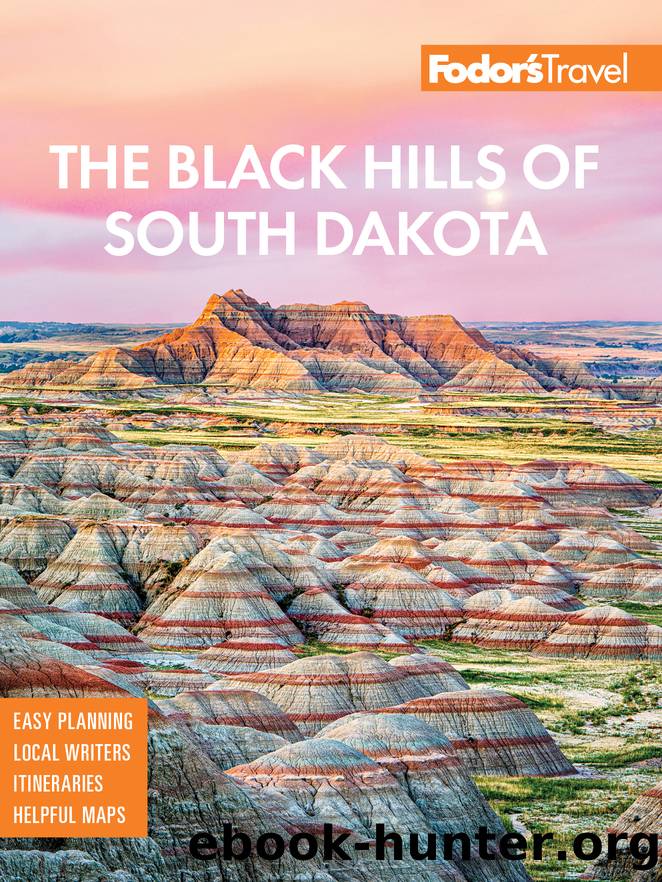Fodor's the Black Hills of South Dakota by Fodor's Travel Guides

Author:Fodor's Travel Guides [Fodor’s Travel Guides]
Language: eng
Format: epub
Publisher: Fodor's Travel
Published: 2021-08-30T00:00:00+00:00
Hot Springs
32 miles south of Custer, 7 miles south of Wind Cave National Park.
Noted for its striking sandstone structures, the small and historic community of Hot Springs (population approximately 3,500) is the gateway to Wind Cave National Park. It is also the entry point to scores of other natural and historical sites, including Evans Plunge, a naturally heated indoor-outdoor pool; The Mammoth Site, where more than 60 mammoths have been unearthed; and one of the regionâs premier golf courses.
GETTING HERE AND AROUND
The easiest and fastest way to reach Hot Springs from Rapid City is to skirt the Black Hills on Highway 79 and then take a short stretch of Highway 18. If youâre already up in the mountains, scenic Highway 385 goes south from Custer through Wind Cave National Park and on to Hot Springs.
Hot Springs Chamber Seasonal Visitor Center. E630 N. River St. P605/745â6974 wwww.visithotspringssd.com.
s Sights
Angostura Reservoir
BODY OF WATER | Thirty-six miles of shoreline, much of it consisting of sandy beaches, surround this man-made lake fringed by forested hills near Hot Springs. Here you can stay in an RV, camping cabin, or tent campsite in one of several large campgrounds operated by the state Department of Game, Fish & Parks. The campgrounds offer kayak rentals, and you can inquire about motorized boat and pontoon rentals with the concessionaire at the marina. If you like fishing, thatâs also popular here, and if you get hungry, thereâs a restaurant near the marina. E13157 N. Angostura Rd. jGo 3 miles south of Hot Springs on U.S. 18 and follow the signs P605/745â6996 wgfp.sd.gov.
All About the Buffalo s
The 1,300-animal-strong Custer State Park bison herd got its start in 1914 when two legendary South Dakotans got together. Peter Norbeck, the governor and later U.S. senator who was instrumental in the parkâs creation, obtained 36 bison (commonly known as âbuffaloâ) from Scotty Philip, who safeguarded some of the last remaining bison on the Great Plains after they were nearly hunted into extinction by the U.S. government in the 1800s.
By 1965, the parkâs bison herd numbered in the thousands, and it was overwhelming the parkâs ability to support it. Thus, the park held its first-ever roundup and auction, to cull the herd back to a manageable size.
The roundups have continued annually ever since and have grown into a visitor spectacle. Thousands of people come to the park in late September every year, where they arrive early in the morning to a roped-off viewing area on a hillside and wait for the herd to come thundering by, pushed along by wranglers on horseback. Thereâs an art festival, held outdoors near the Peter Norbeck Outdoor Education Center, in conjunction with the roundup. See the park website, www.custerstatepark.com, for the festival dates and more information.
But you donât have to attend the roundup to see the bison. They roam freely across much of the park and are especially visible along the Wildlife Loop Road.
There are signs all over the park warning visitors to keep a safe distance when they encounter bison, and those warnings canât be stressed enough.
Download
This site does not store any files on its server. We only index and link to content provided by other sites. Please contact the content providers to delete copyright contents if any and email us, we'll remove relevant links or contents immediately.
Indians on Vacation by Thomas King(521)
Bill Bailey's Remarkable Guide to British Birds by Bailey Bill(468)
Lonely Planet's Ultimate Travel by Lonely Planet(438)
The Outdoor Knots Book by Clyde Soles(434)
The World's Greatest Mountain Ranges - Geography Mountains Books for Kids | Children's Geography Book by Baby Professor(403)
New England Skiing by E. John B. Allen(378)
Hebrides by Peter May & David Wilson(375)
South From Granada by Gerald Brenan(372)
Best Climbs Los Angeles by Damon Corso(372)
Hiking Oklahoma by Jamie Fleck(352)
Fodor’s Bahamas by Fodor’s Travel Guides(342)
Baseball in Tampa Bay by A.M. de Quesada(325)
100 Great Wildlife Experiences by Fair James D.;(315)
A Coney Island Reader by Louis J. Parascandola(307)
Sport by Grand Scott(307)
Fodor’s Oregon by Fodor’s Travel Guides(304)
Desolation Wilderness and the South Lake Tahoe Basin by Jeffrey P. Schaffer(303)
Hikertrash: Life on the Pacific Crest Trail by Erin Miller(299)
Hamish's Mountain Walk by Hamish Brown(298)
